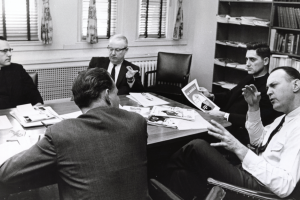Sometime in the late 12th century a monk named Guigo, the second prior of the monastery of the Grand Chartreuse in France, wrote to his friend Gervase about some thoughts he had concerning exercises “proper to a cloistered monk.” Those thoughts, in fact, constitute a tightly argued, pamphlet-sized treatise on how to read scripture as a form of prayer.
Even though his intended audience was a monastic one (lectio divina, or “sacred reading,” is a tradition going back to the beginnings of monasticism), what Guigo had to say in The Ladder of Monks is as pertinent today for all serious Christians as it was when Guigo sent his letter to Gervase.
Guigo’s purpose was not to discuss the technical study of scripture, nor was he thinking of helping those who engage in scriptural study as a resource for preaching or academic teaching. His aim was to show how one could enter into the Word of God in such a way that one would be transformed in the process.
He used the example of nutrition: One takes in food and, in due time, food becomes part of us while also serving as daily sustenance. Guigo, in short, interested himself in the Table of the Word as a companion nourishment to the Eucharist that we receive from the Table of the Bread.
Using the ancient scriptural image of Jacob’s ladder (Gen. 28:12) as symbolic of the ascent to God’s presence, Guigo argues that there are four stages by which we move from a consideration of scripture to prayerful rest in God. He begins with the act of reading (lectio) that leads us to muse over what we have read (meditatio). That reflection, in turn, urges us to respond in prayer (oratio), which finally leads us to quiet rest (contemplatio) in God.
It is clear from a close reading of Guigo’s The Ladder of Monks that he never conceived of these steps in a purely mechanical or systematic fashion. There is no suggestion of a system by which one reads for x number of minutes, then goes to meditate for a period, and so on.
Rather, Guigo thought that the conscious encounter with scripture was a dynamic and holistic exercise. What makes the exercise fruitful is not going through “steps” but the disposition with which we encounter the scriptures.
Guigo does not think of this reading as a way of gaining information or preparing to study for an exam or searching out proof texts for theological argument. His notion of reading is a kind of dialogue in which we read scripture and, in the process, scripture reads us. We approach scripture prayerfully and in faith. In that process, we are led more deeply into faith and into prayer.
While not adhering strictly to Guigo’s method, many contemporary writers have adapted and encouraged this ancient method of prayer as a fruitful vehicle for personal and communal Christian renewal.
Cardinal Carlo Martini, a noted Jesuit scripture scholar and current archbishop of Milan, sponsors reading groups in his diocese aimed especially at young people. Taking a personal and involved part in these exercises, Martini leads meditation groups both in personal appearances and over the radio.
Martini encourages these prayerful encounters in groups both to enhance a sense of community and as a way of fostering deeper Christian commitment while engendering a spirit of Christian activism.
Martini uses the method inherited by Guigo (and pays explicit tribute to Guigo’s treatise) but adds some further steps taken from the Ignatian tradition in which he, as a Jesuit, was formed. He argues that the contemplative reading of scripture should lead people to a moment of discernment (discretio: What is the Word of God saying to me? What choices confront me?) and, further, an understanding of how to act (actio) upon what has been discerned from a prayerful encounter with the Lord.
Martini’s pastoral strategy, then, is to encourage the reader to act on what has been contemplated. He underscores the performative strand that is crucial to a deeply spiritual reading of (or listening to) the Word of God.
While this exercise of reading can be done in a community setting, the ordinary way of sacred reading is for individuals to read in an environment that approximates prayerful solitude. One of the most insightful contemporary writers on sacred reading for the individual is the Australian Trappist Michael Casey.
What Casey suggests for the monk in terms of reading strategies is equally applicable for the layperson. His reflections fall into two broad categories: the aim or purpose of sacred reading and helpful techniques for actually engaging in the practice.
The aim of sacred reading, simply put, is to spend time with the Word of God in such a reflective manner that we are led to a deeper sense of communion with God. Sacred reading is a means by which we make the Word of God our own. It is a form of prayer that can lead us to quiet rest in the presence of God which is what contemplation is. Sacred reading is, in essence, not a prelude to prayer but a way of praying.
How does one pray in this manner? First, it is crucial to relearn the art of attentive reading. So much passes our eyes with speed-scanning newspapers, watching television images flicker by, or surfing the internet that we must learn to allow ourselves to read (Guigo would say “chew”) words slowly and in wonder. We must regain the capacity to savor words.
Casey suggests that we might even use the strategy of writing out scriptural words (not commentaries but the words themselves) or phrases with great care and conscious deliberation. Others have suggested reading the words out loud, which is an imitation of the ancient way of reading.
Second, we should do our reading in a place and under circumstances that say, in effect, that this is a different activity done in quite precise circumstances. Professors should probably get away from their desks; others might find a different room or a different piece of furniture. We could sit on the floor or stand or walk. The important thing is to try to read in a different place from where in our waking hours we “live.”
Third, after getting ourselves composed (for example, with an opening prayer), we should not set a limit as to what we will read. Sacred reading does not mean covering the material. If only a word or a phrase causes us to pause, we should stay with that word or phrase. Perhaps after our session of reading we might carry a pertinent word with us to make that word the basis of our night prayer or prayer during the day.
Fourth, we need to read with some regularity. Many people may find it impossible to read every day because of harried schedules, but we can usually find an appropriate place and a bit of free space and time, preferably when we are not exhausted by daily chores.
Finally, we need to read with a certain determined fidelity. Moments of joy in prayer often give way to patches of boredom, bewilderment, or even resentment. Our own failings may point a moral finger at us as we try to pray. Clutter in our lives may produce mental or emotional static that mutes what scripture may be trying to say to us. One or many of those obstacles may, and probably will, afflict us. We should still read and pray.
Every serious spiritual writer, from St. Teresa of Avila to Thomas Merton, has guaranteed that we will have those periods of restlessness in the life of prayer. Those same masters of the life of prayer all have the same reaction to these periods: keep praying. God is sometimes more present to us in our down moments than we can imagine. The willingness to pray is prayer, no matter how inarticulate it may be.
After her death, the French Catholic convert and social activist Madeleine Delbrel left behind a beaten-up Bible crammed with cinema tickets, clippings, holy cards, notes, gum wrappers, and photos of Gandhi, Charlie Chaplin, and Martin Luther King Jr., among other items. Texts were underlined, annotated, scored, circled, and underlined again. She often did her reading in public places like cafés.
Delbrel’s prayer life was always conceived as an exercise done in solidarity with the world. She called the clutter in her Bible “icons of humanity” and her prayer a “liturgy for life.” She constantly sought ways of creating a path of prayer that she called a “divine office for those who did not recite the divine office.”
What are the fruits of this exercise of sacred reading?
Obviously, if we are to believe Guigo and other writers, it is, first, to lead us to contemplative prayer which Thomas Merton called, variously, “spiritual wonder” or “new depths of faith” or “virginal knowledge.”
Second, the more we familiarize ourselves with the Word of God in a prayerful setting, the more well-worn words from the liturgy leap out and take on new and deeper meanings.
Third, things we think we know (like the creation story or oft-recited psalms) take on a new depth and strangeness when we focus with attention and in a spirit of prayer.
Fourth, we discover that the Word of God speaks back to us, shedding light on who we are, how we live, and the manner in which we relate (or do not relate) to others. The prayerful encounter with the Word of God acts as a catalyst for conversion of life.
In that regard, one recognizes the truth of the observation of the Protestant spiritual writer M. Robert Mulholland Jr., who says that the final step of sacred reading is to take on the Christ who is the Word refracted through the words we encounter in scripture. In that process we find Christ incarnated in our lives as we are nourished by our encounter with the Word of God.
Photo by Joel Muniz on Unsplash













Add comment